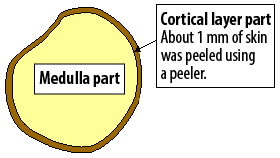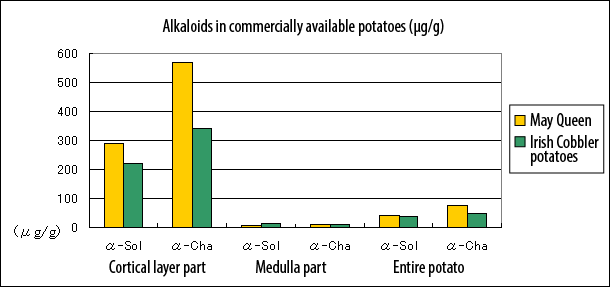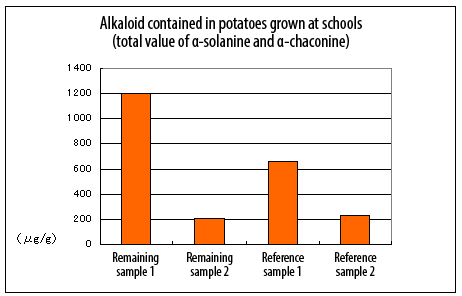Tokyo Food Safety Information Center » Good things to know » Knowledge about potatoes
Knowledge about potatoes
The origin of the potato is the high Andes in South America, and it was introduced to European countries in the early 16th century. It was brought to Japan from Jagatara (Java) in 1601 by Dutch ships, and came to be called “jaga-imo (potato)”. Today, it is an essential ingredient for Japanese meals such as curry and simmered meat and potatoes. Even the familiar potato can be a cause of food poisoning.
Recently, there have been many cases of food poisoning caused by potatoes grown by school children as a part of their classes. Let’s check again how we can prevent it.
1. What is the potato toxin?
The germinating part of potatoes contains alkaloids (mainly α-solanine and α-chaconine), which are the toxic components. It is often contained in the parts exposed to light as well not only the sprouts. The surface of potatoes produce chlorophyll after receiving light and turns green, and alkaloids are produced near the skin as well. It should be noted that even when the skin has not turned green, a large amount of alkaloids may be produced.
Eating potatoes without removing the alkaloids leads to the development of symptoms such as nausea, vomiting, diarrhea, stomachache, feeling of weakness, dizziness, and dyspnea about 20 minutes after eating, and food poisoning may develop although it is generally mild. The toxic dose of alkaloid is commonly considered to be 200 to 400 mg. However, it is about one tenth of this or 20 mg in children.2. How much alkaloid is contained in a potato?
Alkaloid in commercially available potatoes (May Queen and Irish Cobbler potatoes)
Commercially available potatoes (May Queen and Irish Cobbler potatoes: no sprouts developed) contain alkaloids as shown in below graph.
As you can see from this graph, a large amount of alkaloids are contained in the peel (cortical layer) while the edible part (medulla part) contains one-tenth the amount of the alkaloids in the peel.
When 1 mm of skin was peeled, alkaloids were not detected in the edible part.


(α-Sol: α-solanine, α-Cha: α-chaconine)
The mean amount of alkaloids contained in the cortical layer and the medulla part of May Queen is 120 μg/g of potato. Assuming the weight of a potato is 100 g, 12,000 μg (=12 mg) of alkaloids are contained per potato. If 200-400 mg of alkaloid causes poisoning, which is equivalent to about 1.7-3.3 kg of potatoes, commercially available potatoes never cause food poisoning.
However, appropriate measures, for example, peeling the skin or not eating a large amount of potatoes, should be taken for children as they may develop poisoning after ingesting one-tenth the amount of alkaloids (note: 1 mg=1000 μg).
References
- 2004.8, Journal of the Food Hygienics Society of Japan, Vol.45, No.5
3 Why do potatoes grown at school cause food poisoning?
As mentioned above, commercially available potatoes hardly ever cause food poisoning.
However, 12 food poisoning incidents have occurred in schools throughout Japan since 1998.
Why did these incidents happen?

Remaining sample 1: boiled potatoes (12 g)
Remaining sample 2: boiled potatoes (20 g)
Reference sample 1: potatoes remaining in the field (13 g)
The mean alkaloid content in the remaining boiled potatoes was 710 μg/g of potato. This is about six times the level in commercially available potatoes. As children are believed to develop poisoning by ingesting about 20 mg of alkaloid, eating about 30 g of potatoes would put children at risk of food poisoning in this incident.
In this incident, the potatoes were cultivated to use for scientific experiments. Thus, appropriate care, such as thinning, was not taken. Generally, green potatoes are due to inappropriate cultivation, and potatoes harvested while they are still small and immature are thought to contain a large amount of alkaloids.
The Tokyo Metropolitan Government issued a circular to schools to prevent food poisoning caused by cultivated potatoes and raised awareness about precautions.
4 Does cooking decrease alkaloids?
Boiled for 15 minutes
→not decreased.
Heated by 500W microwave for 2 minutes
→decreased by about 15%
*The amount of decreased alkaloid is subject to change depend on microwave intensity, time, material of container for heating, shape, and location to be placed.
Deep fried with oil
→not decreased at 150℃ for five minutes.
Although alkaloids decreased by about 40% at 210℃ for 10 minutes, the potatoes turned dark brown, and were no longer good to eat.
This means……
Toxins in immature potatoes and potato sprouts are not completely eliminated by cooking.
Reference
- 1990.2, Journal of the Food Hygienics Society of Japan, Vol.31, No.1
5 To eat potatoes safely
- Remove the sprouts completely.
- Treat small, immature potatoes grown by yourself with great care as they are considered to contain large amounts of alkaloid.
- Peel greenish skin thickly.
- Potato peel contains larger amounts of alkaloid compared to the edible parts (medulla part), so peel the skin, if possible, for children who may develop poisoning with a small amounts of alkaloid.
- When storing potatoes, keep them in a well-ventilated place covered to protect them from the light.
- Do not eat potatoes if they taste bitter and harsh.